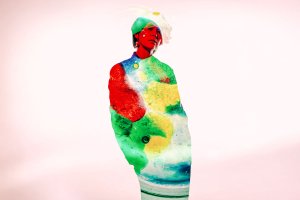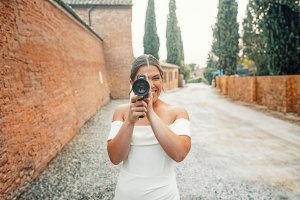Guide to taking artistic photographs: creativity, emotion, and visibility!
Artistic photography is a form of visual expression that goes beyond capturing an image: it seeks to communicate a message or tell a story to the viewer. Through it, the photographer conveys emotions, ideas or personal concepts. And although it is sometimes related to documentary photography, artistic photography is distinguished by the fact that the author creates their own visual universe, often constructing scenes, characters and environments designed to reflect their vision. Each image contains an intention, a hidden narrative or symbolism that invites the viewer to look beyond the obvious.
But being an artistic photographer today is no easy task. You may have your own style, a unique perspective and work that is full of meaning… but if no one sees it, it is as if it does not exist. Many photographers who dedicate themselves to artistic photography face the same problem: a lack of visibility and difficulty selling their work. Showing art in a world saturated with images requires more than just talent: it takes strategy, a digital presence and knowing how to communicate the value of what you do. Because creating with passion is not enough; you also have to learn how to connect with the right audience. And that’s what we’re going to talk about today in this article.

Artistic photography is much more than capturing an image: it is expressing a personal vision, overcoming a lack of visibility, and learning to give value and voice to your art.
Contenido
- What is behind artistic photography?
- Artistic photography: the most common challenges faced by photographers
- Business solutions that enhance artistic photos
- Inspiring examples of photographers who specialise in artistic reportage
- Boost your artistic photography with Arcadina’s business solutions
- Arcadina goes with you
What is behind artistic photography?

Artistic photography is not limited to capturing a moment: it seeks to convey an emotion, tell a story, explore an aesthetic. In this type of work, the photographer acts as a creator of visual universes, composing scenes, directing light, manipulating the environment, or even creating fiction. Creative photography differs from other disciplines because it has a marked aesthetic, symbolic or narrative intention.
Many photography professionals are already venturing into this field, even though they also work in other disciplines. The idea behind these photographers is to differentiate their work over time, express their vision and attract a different type of audience or clientele.
There are several “ingredients” that underpin artistic photography, such as: preparation prior to the shoot, composition, lighting, texture, atmosphere, the underlying idea, direction during the session, editing or post-production (if used), and visibility and marketing. Below we will look at some of these.
Preparing for the artistic session
Before taking any artistic photograph, it is essential to clearly define what you want to convey. It can be an emotion, such as nostalgia, strangeness, joy or melancholy, a visual metaphor or even a complete story that you want the viewer to discover. This initial concept will determine all subsequent decisions: from the choice of lighting, framing and colours, to the costumes, composition and elements of the environment. The clearer your message or intention, the more coherent and powerful the final image will be. It will also allow you to experiment more freely without losing the narrative thread of your artistic project.
- Selecting the model, setting and elements. Choose a model or characters, determine the location or set (it can be a studio, outdoors, or a staged setting), define the styling, costumes and props.
- Lighting, atmosphere and colour. Light will play a fundamental role: intense or soft, directed or diffused, natural or artificial. Colour (or the absence of colour) can reinforce the idea. Think about colour palettes, contrasts, shadows and reflections.
- Camera, lenses and technique. Decide what equipment you will use: camera (full-frame or APS-C), lens (wide angle, medium, telephoto), depth of field, speed, ISO. Although technique is not everything, it helps to capture the idea clearly.
- Prepare the space and time. Prepare the set or location in advance: objects, background, atmosphere, colour temperature. Make sure you have enough time to improvise, experiment and adjust.
Direction during the artistic photography session
Directing during an artistic photography session is much more than just indicating poses or framing: it’s about guiding the visual narrative of your work. As a photographer, your role is to create an environment where the models, objects or settings come to life and reflect the story you want to tell. This involves constant communication, sensitivity, improvisation and attention to every detail, from the expression of a gesture to the interaction with light and the environment. Good direction ensures that each shot has aesthetic and emotional coherence, transforming abstract ideas into striking images that connect with the viewer. Here are some ideas for direction.
- Communication with the model. Although there is not always a human model (it can be a self-portrait, objects, landscape), if there is human participation, it is key to direct with sensitivity: postures, expressions, gaze, interaction with the environment.
- Experimentation and spontaneity. Leave room for improvisation: costume changes, variations in light, unexpected movements, shadow play. Many artistic photos arise from unplanned moments.
- Control of framing and composition. Think about lines, shapes, negatives, patterns, empty spaces that create tension or harmony. Composition can reinforce the visual message.
- Capture details and secondary shots. Don’t just focus on wide shots: also focus on details (textures, hands, objects, reflections) that add richness to the visual narrative.
- Reviews on the fly. Look at some images during the session to see if the idea is coming together, adjust lighting, costumes, attitude, equipment. A quick review halfway through prevents major problems at the end.
Post-production and retouching
Post-production is a key stage in artistic photography; it is the moment when images begin to reveal their true potential. Beyond basic technical adjustments such as exposure, contrast, or white balance, creative retouching allows you to reinforce the narrative, highlight emotions, and give aesthetic cohesion to the series of photographs. In this phase, the photographer can experiment with colour, textures, artificial lighting, or visual effects, always respecting the original intention of the work. Good post-production not only polishes the image but transforms it into a complete work of art, capable of powerfully conveying the story or emotion that inspired the session. Below, we will share several tips for improving these processes.
· Image selection. Choose the ones that best express the idea or emotion you are looking for. It is not about quantity but quality.
· Basic correction and creative editing. White balance, exposure, contrast: the basics. Then, depending on the style, you can apply creative adjustments (partial desaturation, selective colour, grain, textures, overlays) to reinforce the narrative.
· Stylisation and final effect. Stylisation is what turns a photograph into a “work of art”. This can involve digital retouching, collage, double exposure, manual filters, or the use of physical elements (such as smoke, shadow projection, etc.).
· Formats, printing and presentation. Decide how you are going to present the photograph: digital (web, social media), printed (fine art paper, canvas), physical exhibition. The medium is also part of the artistic work.
Distribution, visibility and marketing of artistic photos
Once you have your artistic photos ready, the work is not over; now comes the most arduous task for you. Give them visibility and get them sold to as many people as possible. To do this, in addition to posting them on your social media, it is ideal to have a professional space where you can show your latest work, explain your vision and offer visitors the opportunity to purchase your works. Here are some ideas that may be useful:
- Create a portfolio or artistic website. Once you have a coherent series, create an online portfolio that showcases your artistic work as such, beyond conventional portraiture/commercial production.
- Explain your vision. Although it is true that each project is unique, you can create a section on your photography website where you can explain in words how you approach this type of project.
- Social media, galleries and exhibitions. Consider posting on specialised platforms, participating in competitions or exhibitions, collaborating with other artists or galleries. Visibility requires consistency.
- Sale or commercial use. If your intention is to commercialise your work, define licences (digital, print), prices, formats and shipping. But remember: in artistic photography, the work also has a ‘unique’ or limited edition value.
- Personal branding as an art photographer. Build your visual identity: logo, typography, editing style, narrative behind your work. This will help you position yourself as an artistic photography creator.
Key tips for elevating your artistic photography

In addition to mastering technique and planning each session, there are small details that can make a big difference in artistic photography. Observing other art forms, experimenting with new perspectives, not fearing mistakes, and maintaining constant curiosity are habits that enrich your vision and strengthen your own style. These extra tips will not only help you overcome creative blocks, but also give your work more personality and narrative strength, ensuring that each image has a unique stamp that connects with the viewer. Spend time observing (art, cinema, painting, nature) to enrich your imagination.
And as a final recommendation, here are a few extra tips:
- Don’t be afraid to break the rules of “traditional photography”: asymmetry, blurring, noise, or imperfections can add to the image.
- Be consistent: if your work has a palette, a lighting style, a narrative, stick to it so that your work is recognisable.
- Learn from others but don’t copy: look for references, but develop your own voice.
- Be patient and persistent: artistic photography often does not offer immediate results, but it builds value over time.
Artistic photography: the most common challenges faced by photographers

Being an artistic photographer is much more than capturing beautiful images: it is about creating emotions, telling stories, and conveying your personal vision. However, this path is full of challenges that can frustrate even the most passionate. From lack of visibility to the difficulty of selling or adding value to your work, many photographers face obstacles that go beyond technique. Recognising them is the first step to overcoming them and moving towards more solid and consistent work.
In addition, artistic photography requires a balance between creativity and professionalism. The pressure to maintain your own style, competition in a saturated market, and uncertainty about which works to show the public are common challenges that require strategy, perseverance, and clear communication of your artistic value. Understanding these challenges not only helps you face them with more confidence, but also allows you to turn them into opportunities to evolve and stand out with your photography.
Below, we will highlight the most common problems faced by photographers who dedicate themselves to this more artistic discipline.
I feel that my artistic photography does not have the visibility it deserves
Many artistic photographers feel that their work goes unnoticed, despite the time, effort, and creativity they invest in each image. That feeling of invisibility can be frustrating and discouraging, even for the most passionate. The reality is that, in a world saturated with images, it is not enough to create quality art: you need to learn how to showcase it strategically so that it reaches the right audience and is valued as it deserves.
There are several reasons for this lack of visibility: from not having a strong digital presence, to not taking advantage of all the tools on your website that could give your artistic photography even more visibility, to unclear communication about the value of your work. That’s why it’s important to combine talent with tools and strategies that amplify your voice: from social media and online portfolios, to a services page where you can explain how you work, to specialised articles, to exhibitions and collaborations.
When you succeed in getting your work seen and understood, not only does your personal satisfaction increase, but so do your professional opportunities and recognition within the art world.
I spend hours creating, but no one really sees my work
Spending hours creating an artistic photograph can be exciting, but also frustrating when you feel that no one really sees your work. That feeling of wasted effort is common among photographers who invest time in perfecting every detail, from composition and lighting to the narrative of the image, only to find that their work goes unnoticed. Beyond creation, visibility is key: if your work doesn’t reach those who can appreciate it, some of the value you’ve so carefully built is lost.
The problem isn’t your talent, but how you present and share your work. Having a coherent portfolio, curating your online presence, choosing the right channels for your audience, and clearly communicating your vision are essential steps in getting your images seen and understood. When you succeed in getting your work noticed, not only does your professional recognition increase, but it also boosts your motivation and allows you to continue creating with more confidence and artistic freedom.
My photography has soul, but I lack the strategy to sell it
Your photography may have soul, style, and a powerful narrative, but even the most impressive work needs strategy to reach the right audience and generate professional opportunities. Many artistic photographers face the same challenge: creating images that excite and communicate, but not knowing how to present, position, or sell them effectively. A lack of strategy does not invalidate your talent, but it can limit the recognition and profitability of your work.
Developing a clear plan does not mean losing creative freedom: it is about learning to communicate the value of your art, identifying your target audience, selecting the right channels (online portfolio, social media, galleries, collaborations) and deciding how to display or market your work. When you combine creativity with strategy, your photography not only conveys emotions, but also gains visibility, impact and opportunities for professional growth, transforming your passion into a sustainable and recognised project.
I find it difficult to make a living from my art as an artistic photographer
Many artistic photographers face the same reality: they devote hours and effort to creating works full of emotion and creativity, but they struggle to turn that talent into sustainable income. Making a living from art is not easy, especially in a sector where competition is high and the value of artistic work is not always understood or recognised. This difficulty can lead to frustration and cause some artists to question their career path, despite producing quality work.
The challenge is not your talent, but how you position and market your art. Learning how to set prices, identify your audience, communicate the value of your photographs, and use appropriate sales channels (client galleries, exhibitions, online portfolios, digital licences) can make the difference between creating as a hobby and creating as a viable profession. Combining artistic passion with commercial strategy allows you not only to survive financially, but also to grow as a creator and build a sustainable career in the world of artistic photography.
Business solutions that enhance artistic photos
When it comes to solving all these problems faced by photographers who want to make a living from their art, it is important to choose a set of tools that allow you, on the one hand, to give greater visibility to your artistic creations and, on the other, to generate income in a way that is simple for your clients and effective for you.
At Arcadina, we have a series of business solutions designed by and for photographers that will allow you to increase your visibility, generate sales, automate processes and make your day-to-day life easier. If you are not yet familiar with them, we encourage you to try them out.
But today we are going to focus on two of them in particular: photography websites and public customer galleries (also known as online shops).
Thanks to these two business solutions, you will be able to give your artistic photographs greater visibility and ensure that many of the visitors to your website end up purchasing some of your work. Below, we will discuss all of their advantages in more detail.
Photography website to showcase your creative works

Having your own photography website is much more than just a showcase: it is a space completely under your control, where you can display your work exactly how you want it to be seen. Here you have the freedom to select your best photographs, organise them by style or project, and create a visual narrative that reflects your vision and personality as an artistic photographer.
In addition, your website allows you to clearly explain your services and how you work, so that any visitor or potential client understands what you offer and how you can help them realise their idea. You can incorporate a news section, ideal for informing about upcoming exhibitions, workshops, collaborations or special projects, keeping your audience up to date and encouraging interaction.
Another great advantage of having your own site is the possibility of sharing your career path, telling the story of your evolution as a photographer, the challenges you have overcome and the most important milestones in your career. You can even enable a space for comments, reviews or ratings, which not only builds trust and credibility, but also allows you to create a community around your work. In short, a professional website is a strategic tool that combines presentation, communication and promotion, helping you to consolidate your presence and connect with those who truly appreciate your artistic photography.
Web portfolio
The image galleries on your website are much more than just a space to hang your photographs: they are the digital calling card for your artistic work. Not only will you be able to display your photos in full size, with the quality they deserve, but you will also have the freedom to customise the design as many times as you like, adapting colours, styles and formats so that each project has its own character.
In addition, you can create multiple galleries and sub-galleries, organising your series in a clear and coherent manner and allowing visitors to navigate your portfolio intuitively. It is even possible to integrate an Instagram gallery, showcasing your activity on social media without losing control of your professional presentation. Each image can be accompanied by brief descriptions, stories or technical details, providing context and enriching the viewer’s experience.
But the most interesting thing is that these galleries allow you to add endless customised details: tags, titles, transition effects, contact buttons or links to related projects. All this turns your portfolio into a dynamic, attractive and professional space, where your artistic photography is not only seen, but also tells its story, reflects your style and shines with its own light before any visitor.
Services pages
Text-based pages on your website are the perfect tool for giving context and depth to your artistic portfolio. It’s not just about showing images, but accompanying them with explanations that help visitors understand your way of working, your sources of inspiration and the details that make your photo shoots unique. This type of content allows your work to not only be seen, but also felt and understood, reinforcing the emotional connection with those who view it.
In addition, these pages are ideal for creating a professional biography where you introduce yourself as an artist, recount your career and share important achievements such as awards, exhibitions, courses, collaborations or any other relevant news . By providing this information, you not only build credibility and trust, but also give your visitors the opportunity to get to know the author behind the images. Together, these text sections enrich your portfolio, turning your website into a comprehensive space where your art is displayed, explained, and contextualised in a professional and attractive way.
Client galleries to sell your artistic images

Once your work has started to gain visibility, it is essential to make it easy for your website visitors to purchase your artistic photos. Having a system that allows users to browse your portfolio, select their favourite images and purchase them in digital format or as printed copies quickly and automatically, without the need for direct contact, can make a big difference to your business.
This type of functionality not only increases customer convenience and satisfaction, but also turns your website into a professional and efficient sales platform, capable of generating income while you focus on creating new works. In addition, by offering different format, size and finish options, you are giving the buyer freedom and increasing the chances of a sale. In short, integrating an automated purchasing system not only optimises the visitor experience, but also opens up new opportunities to monetise your art in a professional and scalable way.
Inspiring examples of photographers who specialise in artistic reportage
In this section, you can include a selection of photographers with outstanding artistic photography projects that will serve as inspiration. It’s not just about naming them, but accompanying each reference with a brief comment on their approach, style, and what can be learned from their work. This allows your readers to discover relevant references, understand different approaches to artistic photography, and be motivated to explore new ideas for their own projects.
For example, you can mention how one photographer masters natural light to convey emotions, how another combines portraiture with landscape to tell stories, or how a specific project stands out for its originality in composition or visual narrative. These references not only enrich your article, but also offer practical and educational examples, helping your readers to be inspired and better understand the different paths that artistic photography can take.
1# Jesús Tozán
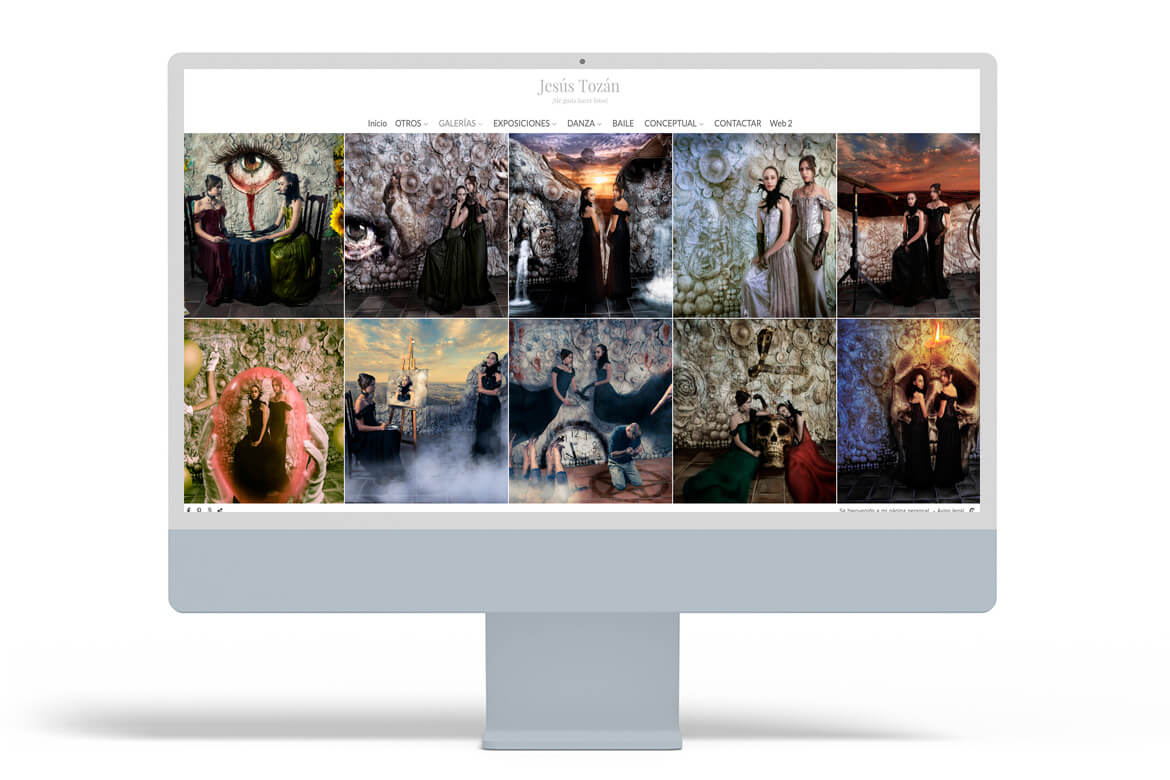
We begin this section on artistic photography with Jesús Tozán, a photographer from Alcalá de Henares (Madrid) whose greatest passion is taking artistic photographs. As he states on his Arcadina website, photography serves as a refuge and even therapy for him, helping him to feel good.
His photographs convey history, technique and creativity to show you everything from the harshest reality to a completely imaginary and fictional world. A world within our world waiting to be seen. Do you dare to enter?
2# Loly Villoch
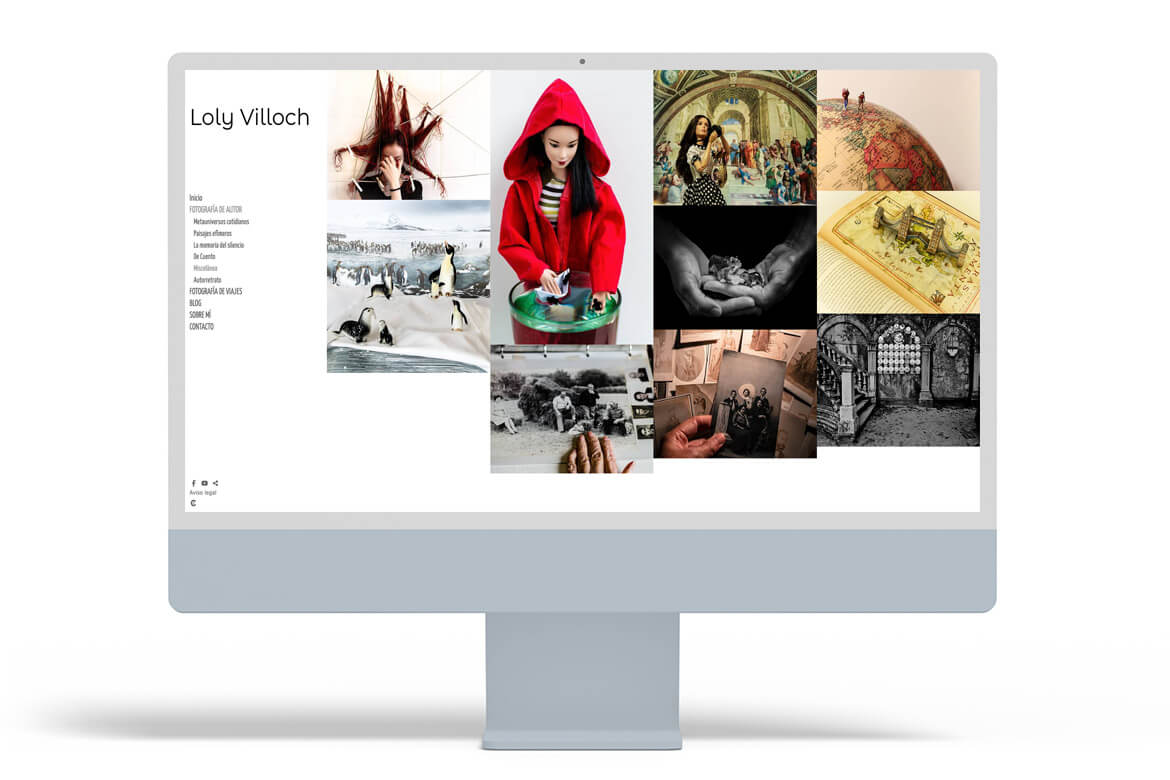
On photographer Loly Villoch’s website, you will discover a very unique vision of the world through her galleries. This photographer from A Coruña uses photography as a means of expression.
In her image galleries, in addition to her different creative photography portfolios (everyday meta-universes, ephemeral landscapes, the memory of silence, miscellany and self-portraits), you will also be able to enjoy some of her underwater photographs that will not leave you indifferent.
3# A G Redondo Fotografía
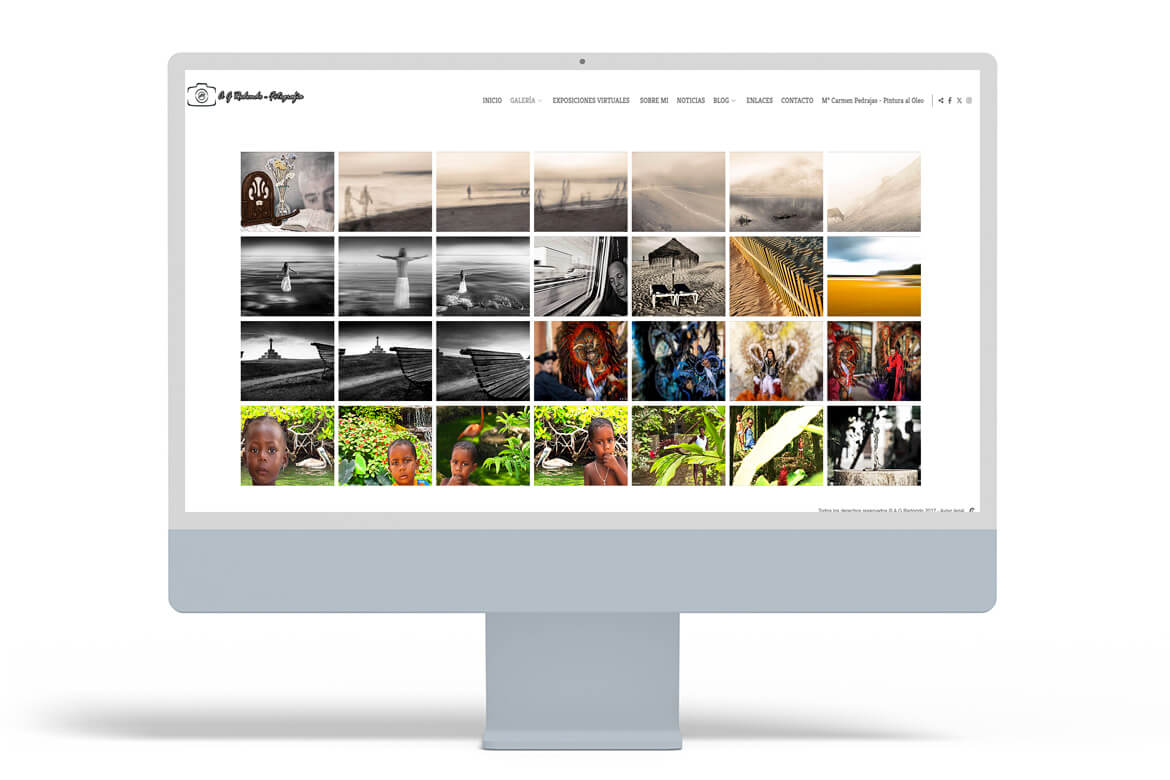
Behind this other artistic photography website, A G Redondo Photography, is Antonio. This photographer loves to discover new corners of the world and their cultures, and he uses his camera to recount everything he encounters on each of his travels.
After travelling halfway around the world (Senegal, Ethiopia, Colombia, Venice and Paris), Antonio displays some of his travel, author and documentary photography reports in various exhibitions and in the galleries on his website.
4# Bernard Larroque
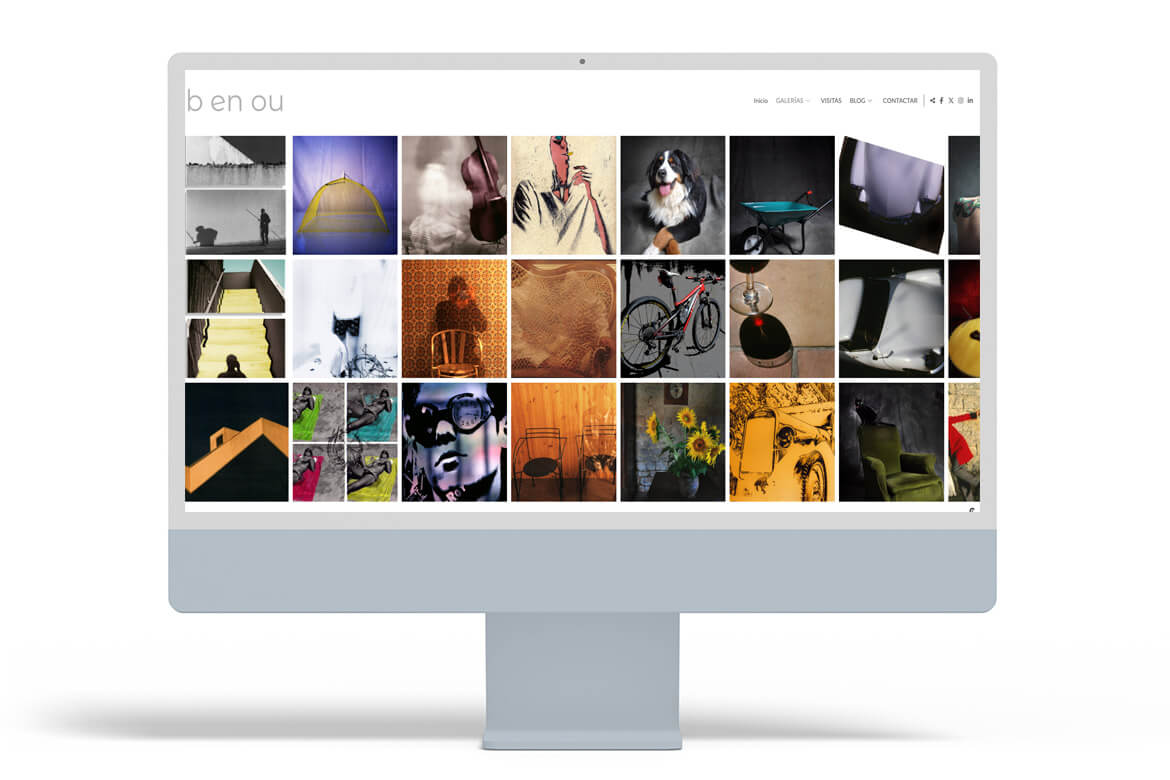
Bernard is a French photographer based in Madrid who uses his website Bernard Larroque (b en ou) as an online gallery.
If you take a look at his website, you won’t find much information about his work or Bernard’s life, but you will be able to enjoy an extensive collection of images from his travels (Cuba, Miami), the world of bullfighting, nudes, portraits of strangers and celebrities, his vision of life and even a tribute to photographer Ralph Gibson.
5# 68 Ródenas

Behind the 68 Ródenas website you will find Josep, a photographer from Sabadell who specialises in artistic portraits, dance photography, bodies in motion and visual narratives.
On his website, you will find a fantastic example of his more personal and travel-related portfolio. And while you’re on his website, take the opportunity to visit his blog, where you will find some very interesting articles.
6# Javier Martín Bolea
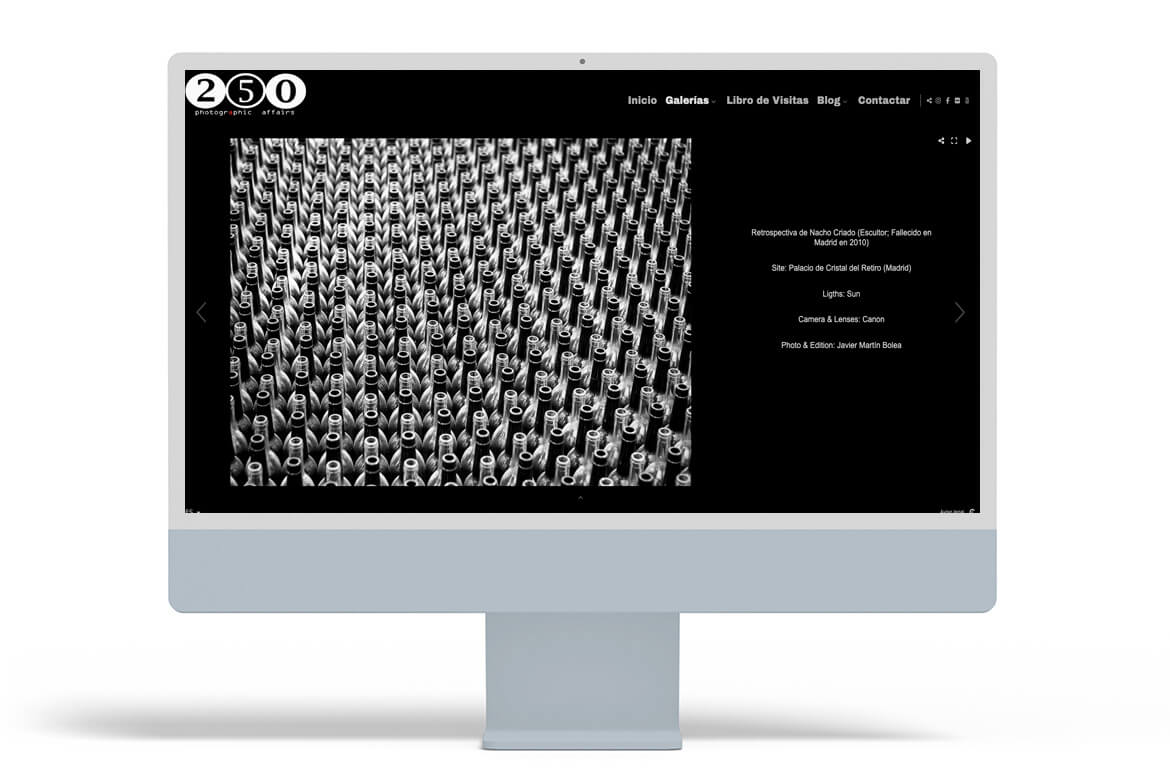
We conclude this brief but intense compilation of professionals who dedicate part of their work to artistic photography with the website of Javier Martín Bolea, a photographer from Madrid who specialises in working with models, portfolios, personalised sessions, artistic photography, etc.
On his website, you can enjoy an extensive and carefully curated gallery of images where, in some of his most groundbreaking works, he has added a series of information to each image that may be useful to his followers.
Below, we are going to share with you a compilation of creative photography that you will love.
>> Be inspired by creative photography! Discover 10 truly creative photographers
Boost your artistic photography with Arcadina’s business solutions
Artistic photography is a deeply personal and creative journey. It is not just about capturing “a pretty picture”, but about creating images that speak for themselves, invite reflection and arouse emotions in the viewer. Every decision, from the conception of the idea, through the preparation and execution, to the editing and final presentation, contributes to the coherence, aesthetic strength and narrative of your work.
Following this guide will allow you to explore your artistic vision more consciously and effectively, helping you to transform abstract ideas into striking images. Remember that artistic photography is also a space to experiment, take risks and express your identity as a creator. Dare to show your unique perspective, play with light, colours and compositions, and allow each photograph to tell its own story. Expressing yourself freely and confidently is the key to ensuring that your work is not only seen, but also resonates and connects with those who view it.
With Arcadina, you can create your own personal artistic and conceptual photography website. If you are a photographer, it is vital to have your own permanent website where you can upload all your work, and you can also sell your photos securely. You choose the prices, formats, shipping method, everything. To try it out, you can create a free website for 14 days with no obligation here:
Are you an Arcadina user and want to appear in our publications? It’s as easy as letting us know at😉 . We’d be delighted to review your website. Write to us here.
Arcadina goes with you
Fulfil your dreams and develop your career with us. We offer you to try our web service free for 14 days. And with no commitment of permanence.
Arcadina is much more than a website, it is business solutions for photographers.
If you have any queries, our Customer Service Team is always ready to help you 24 hours a day, 7 days a week. We listen to you.


